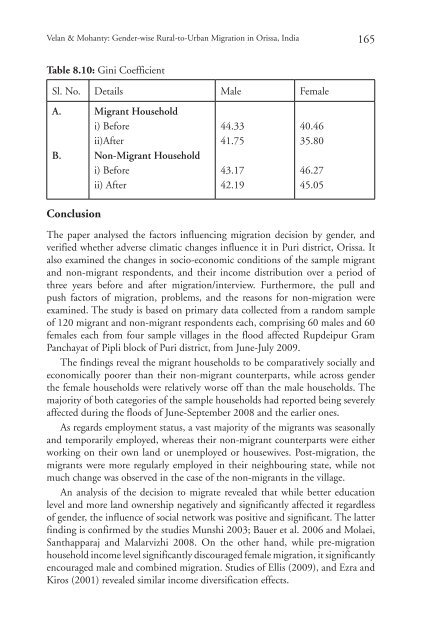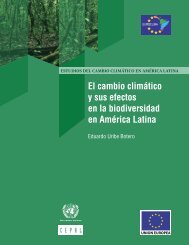Inequality and Climate Change Inégalité et changement climatique
Inequality
Inequality
Create successful ePaper yourself
Turn your PDF publications into a flip-book with our unique Google optimized e-Paper software.
Velan & Mohanty: Gender-wise Rural-to-Urban Migration in Orissa, India 165<br />
Table 8.10: Gini Coefficient<br />
Sl. No. D<strong>et</strong>ails Male Female<br />
A.<br />
B.<br />
Migrant Household<br />
i) Before<br />
ii)After<br />
Non-Migrant Household<br />
i) Before<br />
ii) After<br />
44.33<br />
41.75<br />
43.17<br />
42.19<br />
40.46<br />
35.80<br />
46.27<br />
45.05<br />
Conclusion<br />
The paper analysed the factors influencing migration decision by gender, <strong>and</strong><br />
verified wh<strong>et</strong>her adverse climatic changes influence it in Puri district, Orissa. It<br />
also examined the changes in socio-economic conditions of the sample migrant<br />
<strong>and</strong> non-migrant respondents, <strong>and</strong> their income distribution over a period of<br />
three years before <strong>and</strong> after migration/interview. Furthermore, the pull <strong>and</strong><br />
push factors of migration, problems, <strong>and</strong> the reasons for non-migration were<br />
examined. The study is based on primary data collected from a r<strong>and</strong>om sample<br />
of 120 migrant <strong>and</strong> non-migrant respondents each, comprising 60 males <strong>and</strong> 60<br />
females each from four sample villages in the flood affected Rupdeipur Gram<br />
Panchayat of Pipli block of Puri district, from June-July 2009.<br />
The findings reveal the migrant households to be comparatively socially <strong>and</strong><br />
economically poorer than their non-migrant counterparts, while across gender<br />
the female households were relatively worse off than the male households. The<br />
majority of both categories of the sample households had reported being severely<br />
affected during the floods of June-September 2008 <strong>and</strong> the earlier ones.<br />
As regards employment status, a vast majority of the migrants was seasonally<br />
<strong>and</strong> temporarily employed, whereas their non-migrant counterparts were either<br />
working on their own l<strong>and</strong> or unemployed or housewives. Post-migration, the<br />
migrants were more regularly employed in their neighbouring state, while not<br />
much change was observed in the case of the non-migrants in the village.<br />
An analysis of the decision to migrate revealed that while b<strong>et</strong>ter education<br />
level <strong>and</strong> more l<strong>and</strong> ownership negatively <strong>and</strong> significantly affected it regardless<br />
of gender, the influence of social n<strong>et</strong>work was positive <strong>and</strong> significant. The latter<br />
finding is confirmed by the studies Munshi 2003; Bauer <strong>et</strong> al. 2006 <strong>and</strong> Molaei,<br />
Santhapparaj <strong>and</strong> Malarvizhi 2008. On the other h<strong>and</strong>, while pre-migration<br />
household income level significantly discouraged female migration, it significantly<br />
encouraged male <strong>and</strong> combined migration. Studies of Ellis (2009), <strong>and</strong> Ezra <strong>and</strong><br />
Kiros (2001) revealed similar income diversification effects.





